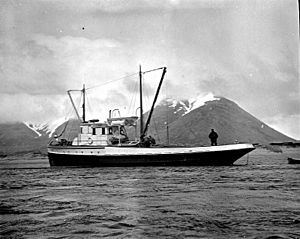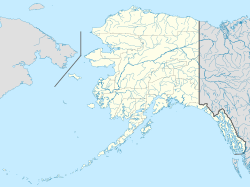King Cove, Alaska facts for kids
Quick facts for kids
King Cove
Agdaaĝux̂
|
|
|---|---|

Pacific American Fisheries cannery ship Kenmore in King Cove, May 1912
|
|
| Country | United States |
| State | Alaska |
| Borough | Aleutians East |
| Incorporated | September 9, 1949 |
| Area | |
| • Total | 29.20 sq mi (75.62 km2) |
| • Land | 24.66 sq mi (63.88 km2) |
| • Water | 4.53 sq mi (11.74 km2) |
| Elevation | 92 ft (28 m) |
| Population
(2020)
|
|
| • Total | 757 |
| • Density | 30.69/sq mi (11.85/km2) |
| Time zone | UTC-9 (Alaska (AKST)) |
| • Summer (DST) | UTC-8 (AKDT) |
| ZIP code |
99612
|
| Area code | 907 |
| FIPS code | 02-39410 |
| GNIS feature ID | 1418792 |
| Website | http://www.cityofkingcove.com/ |
King Cove is a small city in Aleutians East Borough, Alaska, United States. Its name in the native Aleut language is Agdaaĝux̂. The city is located on the Alaska Peninsula, which is a long piece of land stretching out into the Pacific Ocean.
King Cove's population has changed over the years. In 2010, there were 938 people living there. By 2020, the population had gone down to 757 people.
Contents
Where is King Cove?
King Cove is located on the Pacific side of the Alaska Peninsula. It is about 18 miles (29 km) southeast of a place called Cold Bay. The city is also about 620 miles (1,000 km) southwest of Anchorage, which is Alaska's largest city.
The total area of King Cove is about 29.8 square miles (77.2 square kilometers). Most of this area, about 25.3 square miles (65.5 square kilometers), is land. The rest, about 4.5 square miles (11.7 square kilometers), is water.
How Many People Live in King Cove?
King Cove first appeared in the U.S. Census in 1940. It officially became a city in 1949.
| Historical population | |||
|---|---|---|---|
| Census | Pop. | %± | |
| 1940 | 135 | — | |
| 1950 | 162 | 20.0% | |
| 1960 | 290 | 79.0% | |
| 1970 | 283 | −2.4% | |
| 1980 | 460 | 62.5% | |
| 1990 | 451 | −2.0% | |
| 2000 | 792 | 75.6% | |
| 2010 | 938 | 18.4% | |
| 2020 | 757 | −19.3% | |
| U.S. Decennial Census | |||
In 2000, there were 792 people living in King Cove. About 45% of households had children under 18. The average household had about three people. The median age of people in the city was 35 years old.
What is King Cove's Economy Like?
King Cove's economy mostly depends on commercial fishing and seafood processing. It is home to a very large seafood processing plant owned by PeterPan Seafoods. This plant processes many different types of fish caught in the nearby Bering Sea and Gulf of Alaska.
Some of the fish processed here include:
- King Crab
- Tanner crab (like bairdi and opilio)
- Pollock
- Cod
- Salmon
- Halibut
- Black cod
The plant has a long history, going back to the early 1900s. It has the largest capacity for canning salmon in all of Alaska. All five types of salmon found in Alaska are plentiful in the waters near King Cove.
While salmon is still very important, the plant has also grown its operations for whitefish. They make different products like pollock fillets and salt cod. During busy seasons, especially in winter and summer, almost 500 people work at the plant. Many local residents also have permits to fish commercially. People also get food by hunting and gathering, which is called subsistence living.
Transportation in King Cove
King Cove has a state-owned airport called King Cove Airport. It has a gravel runway. Local companies like Eider Air offer air taxi and charter flights. Another company, Grant Aviation, also flies to King Cove and handles mail delivery.
The city is also connected by the Alaska Marine Highway. This is a state-run ferry service. It links King Cove to Cold Bay to the west and Sand Point to the east.
Proposed Road to Cold Bay
There has been a long discussion about building a road between King Cove and Cold Bay. This road is partly built already. The people who support the road say it is very important for safety. They argue that it would help transport people who need urgent medical care to a larger airport in Cold Bay. Sometimes, planes cannot land or take off from King Cove's airport because of bad weather or darkness.
However, many groups, like The Wilderness Society, are against the road. They believe it would cause serious harm to the Izembek National Wildlife Refuge. This refuge is a protected area for wildlife. Opponents also think the road is mainly for commercial fishing businesses, not just for medical emergencies.
Several government officials and courts have been involved in this debate:
- Former Interior Secretary Sally Jewell decided against the road.
- Later, Interior Secretary Ryan Zinke signed an agreement to allow the road.
- But a judge, Sharon Gleason, stopped the road in 2019. She said Secretary Zinke did not properly address environmental concerns.
- In 2020, Secretary David Bernhardt approved a new agreement, trying to address the environmental issues.
- However, another judge, John W. Sedwick, also blocked this plan. He felt the environmental concerns were still not fully answered.
- The Trump administration appealed this decision.
- In 2021, the Biden administration decided to continue the appeal. This means the debate about the road is still ongoing.
Healthcare in King Cove
The King Cove Community Health Clinic provides medical care for residents. It is managed by the Eastern Aleutian Tribes. The clinic offers regular medical check-ups, mental health support, and emergency care. It is open during weekdays. For emergencies after hours, there are practitioners on call.
King Cove also has a local group of emergency medical services (EMS) who provide ambulance service. Healthcare is also given by Community Health Aide Practitioners. These are special healthcare providers unique to Alaska.
Education in King Cove
The Aleutians East Borough School District (AEBSD) runs the King Cove School. In 2019, the school had 13 teachers and about 85 students.
See also
 In Spanish: King Cove (Alaska) para niños
In Spanish: King Cove (Alaska) para niños


